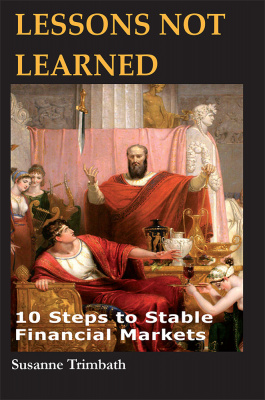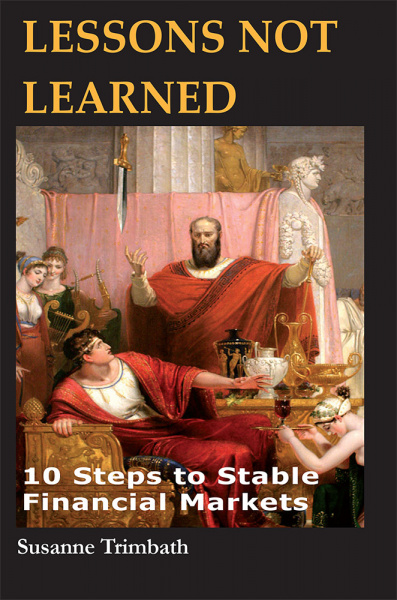Lessons Not Learned
10 Steps to Stable Financial Markets
Much has been written and spoken about the lessons learned from the financial crisis of 2009. In this book, we list the lessons not learned before the financial crisis. The purpose of this book is to demonstrate that the theoretical and intellectual frameworks for regulating financial systems that had been available since at least 2001 could have prevented the systemic failure in the United States that led to the collapse of global credit markets in 2008.
- AvailablePaperback9781910151235288 pagesList Price: GBP 24.95 Add to basket
- AvailableHardback9781910151242288 pagesList Price: GBP 45.00 Add to basket
- AvailablePDF9781910151259288 pagesList Price: GBP 9.95 Add to basket
Much has been written and spoken about the lessons learned from the financial crisis of 2009. This book deals with the lessons not learned before the financial crisis.
Dr Trimbath demonstrates that an existing framework for regulating financial systems, available since at least 2001, could have prevented the systemic failure in the US that led to the collapse of global credit markets in 2008. Step by step the book guides you through what could have been done to prevent the crisis and what investors can do to protect themselves from the next one, and concludes with a key idea for making financial services businesses stand out from the crowd ensuring future success.
The list of 10 Steps is quite straight-forward and simple.
- Have private, independent rating agencies.
- Provide some government safety net but not so much that banks are not held accountable (“Too Big to Fail”)
- Allow very little government ownership and control of national financial assets.
- Allow banks to reduce the volatility of returns by offering a wide-range of services.
- Require financial market players to register and be authorized.
- Provide information, including setting standards, to enhance market transparency.
- Routinely examine financial institutions to ensure that the regulatory code is obeyed.
- Enforce the code and discipline transgressors.
- Develop policies that keep the regulatory code up to date.
- Encourage the creation of specialized financial institutions.
For each step the reader will find: the legislative and regulatory background on the existing rules; a review of academic research on the theory behind each step; and the facts and data connecting each step to the financial crisis of 2008.
"In a time of mind-boggling complexity in financial regulation - too complex, according to Ben Bernanke, for the Federal Reserve System to understand its impact - Lessons Not Learned is a refreshing call to return to a simpler, more basic approach. Susanne Trimbath emphasizes that the failure to implement regulations, a key factor in the crisis of 2008, remains the system's Achilles heel. This book features a refreshing combination of research grounding and pragmatic experience. A must read for taxpayers and their representatives!"
Jerry Caprio - Currently: Williams College, William Brough Professor of Economics and Chair, Center for Development Economics. Formerly (1988-2005): The World Bank, Director, Operations and Policy Department, Financial Sector Vice Presidency
Acknowledgements
About the author
Contents
Abbreviations
Tables of authorities
Foreword
Introduction
1. Updated Regulations
1.1. Lesson
1.2. Purpose
1.3. Theory
1.4. Practice
1.5. Connection
1.6. Conclusion
2. Registration and Authorisation
2.1. Lesson
2.2. Purpose
2.3. Theory
2.4. Practice
2.5. Connection
2.6. Conclusion
3. Surveillance and Examinations
3.1. Lesson
3.2. Purpose
3.3. Theory
3.4. Practice
3.5. Connection
3.6. Conclusion
4. Allowable Diversification
4.1. Lesson
4.2. Purpose
4.3. Theory
4.4. Practice
4.5. Connection
4.6. Conclusion
5. Independent Monitors
5.1. Lesson
5.2. Purpose
5.3. Theory
5.4. Practice
5.5. Connection
5.6. Conclusion
6. Information and Standards
6.1. Lesson
6.2. Purpose
6.3. Theory
6.4. Practice
6.5. Connection
6.6. Conclusion
7. Enforcement and Discipline
7.1. Lesson
7.2. Purpose
7.3. Theory
7.4. Practice
7.5. Connection
7.6. Conclusion
8. Safety with Accountability
8.1. Lesson
8.2. Purpose
8.3. Theory
8.4. Practice
8.5. Connection
8.6. Conclusion
9. Private Ownership
9.1. Lesson
9.2. Purpose
9.3. Theory
9.4. Practice
9.5. Connection
9.6. Conclusion
10. Specialization
10.1. Lesson
10.2. Purpose
10.3. Theory
10.4. Practice
10.5. Connection
10.6. Conclusion
11. Conclusion
11.1. Finance is Everywhere
11.2. No single cause, no single solution
11.3. Moving Beyond Finance and Economics
11.4. Where We Are Now
11.5. Where we could be
11.6. Epilogue to Individual Investors
Appendices
Appendix 1: Note on the Mathematics of Derivatives
Appendix 2: SROs, Born of the Paperwork Crisis
Appendix 3: Structured Finance
Appendix 4: Who Regulates Banks
Appendix 5: DFA Cross-Reference and Implementation Trackers
Appendix 6: A Collection of Lessons
References
Index


